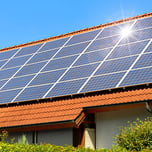
Get up to 4 quotes by filling in only 1 quick form

Slash your energy bills by installing solar panels

We’ve helped over 500,000 homeowners reduce their carbon footprint
- GreenMatch
- Blog
- Concentrated Solar Power Explained
Concentrated Solar Power Explained
What is CSP and how does it work?
Solar PV panels are not the only way of generating clean energy from harnessing the sun’s power. Concentrated solar power (or concentrated solar thermal) is a technology that uses mirrors to concentrate sunlight onto a tube or tiny spot, which in turn converts the light into heat. Instead of using that heat directly, as do solar thermal collectors, these systems utilise it to power a steam engine connected to a power generator.
The idea of concentrating sunlight with mirrors and lenses is actually centuries old: although scientists doubts about its accuracy, Archimedes documented that the ancient Greeks used mirrors and light to set enemies’ ships on fire.
Large CSP plants are being built all over the world, and they’re becoming especially popular in places like the Middle East, which have an excellent insulation and benefit from large portions of unused, desert land.
Types of Concentrated Solar Power Technologies
- Parabolic Trough: these CSP systems are the most developed currently, and consist in parabolic reflectors that concentrate light into linear receivers. The receivers are positioned exactly in the middle of the parabola and contain a fluid that gets heated by sunlight to power the generator. They incorporate trackers so that the system follows the sun for maximum exposure.
- Fresnel Reflectors: several flat mirror strips are combined to concentrate sunlight onto the tubes where the liquid flows. Flat mirrors are less expensive than parabolic ones, making these systems cheaper.
- Dish Stirling: these innovative Concentrated Solar Power technologies have shown great potential in terms of solar efficiency, with new models reaching up to 34% efficiency. They are made up of large, standalone parabolas that concentrate the light into a small spot. The receiver contains the working liquid, which when heated powers a Stirling engine. The dish reflector follows the sun more accurately than other systems.
- Solar Tower: in this case tracking reflectors point to a single tower containing a fluid (such as sea water) that is used for heat generation. At any time the reflectors can be moved without having to modify the tower’s position, which is an advantage of these systems.
Concentrated Solar Power’s Future
CSP has great potential for growth, and could be covering up to 25% of the world’s energy demand by 2050. Many countries are investing in this technology, with Spain leading the way with more than 50 projects.
The biggest disadvantage of CSP systems is that they work best in places with high insulation, so they may not be suitable for all geographical locations. However places like South America and Africa are great candidates and are predicted to see a huge growth in installations of this kind.
Another drawback of concentrated solar power plants is that they might be dangerous to wildlife, since birds flying too close to the concentrated rays can be killed by the intense heat. However, statistics have shown that the number of fatalities is far lower than that caused by power lines and cars, for instance.
Far more problematic is the need for land to install large systems, since they can’t take advantage of roof space like solar panels. However, the easy solution would be to utilise “low quality” land that is unsuitable for cultivation.
Fill in the form in just 1 minute
We strive to connect our customers with the right product and supplier. Would you like to be part of GreenMatch?




